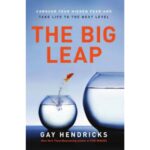LISTEN NOW
Outline: The Big Leap by Gay Hendricks
Outline
Expand to Read ...
Introduction
- Purpose: Helps readers overcome psychological barriers (the “Upper Limit Problem”) to achieve success and fulfillment.
- Target Audience: Accomplished individuals feeling unfulfilled despite success.
- Core Concept: A self-imposed “happiness threshold” limits the level of success and positivity we allow ourselves to experience, leading to self-sabotage.
Key Concepts
- Happiness Threshold:
- Defined as the maximum level of positivity we feel comfortable experiencing.
- Shaped by early life experiences and false beliefs.
- Crossing this threshold enables access to a “Zone of Genius,” characterized by fulfillment.
- Upper Limit Problem:
- Subconscious behaviors that prevent exceeding the happiness threshold.
- Examples: self-sabotage, guilt, fear of success, and unworthiness.
Levels of Success
- Stagnancy:
- Minimal accomplishment, often due to neglecting strengths.
- Leads to frustration and inertia.
- Example: Stuck in a dead-end job that doesn’t align with natural abilities.
- Adequacy:
- Moderate progress and societal approval, but lacking personal fulfillment.
- Marked by a plateau in growth and potential.
- High Achievement:
- Societal recognition for success, but accompanied by:
- A sense of something missing.
- The emergence of the happiness threshold, often resulting in self-sabotage.
- Societal recognition for success, but accompanied by:
- State of Fulfillment:
- The ultimate goal: living a life of boundless joy, growth, and contribution.
- Overcoming the happiness threshold unlocks unlimited potential.
The Happiness Threshold and Its Impact
- Broad Influence:
- Affects all areas of life—wealth, relationships, health, and personal growth.
- Ignoring the call to fulfillment can lead to depression, illness, and failure.
- Self-Sabotage:
- Unconscious behaviors that undermine success and happiness, such as:
- Poor financial habits.
- Relationship conflicts.
- Risky or destructive choices.
- Unconscious behaviors that undermine success and happiness, such as:
Origins of Limiting Beliefs
- False Beliefs Shaped in Childhood:
- Influence feelings of unworthiness, guilt, or fear of success.
- Common false beliefs:
- “I am flawed at my core, so I cannot be successful.”
- Originates from early rejection or criticism.
- Creates cognitive dissonance between success and perceived flaws.
- “My success would betray my roots.”
- Stems from feeling at odds with family or cultural expectations.
- “My success would hurt someone else.”
- Linked to guilt over outshining peers or family members.
- “Great success ends in great ruin.”
- Rooted in cautionary tales of downfall following achievement.
- “I am flawed at my core, so I cannot be successful.”
Identifying and Addressing Limiting Beliefs
- Self-Reflection:
- Observe recurring behaviors that reinforce limiting beliefs.
- Examples:
- Habitual worry.
- Criticism of others.
- Struggling to accept compliments.
- Illness or injury following joyful experiences.
- Non-Judgmental Awareness:
- Acknowledge behaviors without self-criticism.
- Cultivate curiosity and openness toward change.
Restrictive Behaviors in Relationships
- Collaborative Self-Limitation:
- Partners may reinforce a shared happiness threshold.
- Strategies to address this:
- Take individual time for self-reconnection.
- Enhance communication skills.
- Practice non-sexual physical affection.
- Build a support network with trusted friends.
Discovering Your Passion and Fulfillment
- Defining Fulfillment:
- Fulfillment is the alignment of your passions, talents, and contributions.
- Reflective Questions:
- What activity feels effortless and energizing?
- What aspects of your current work bring the most satisfaction?
- What unique talents or gifts do you possess?
- Crafting a Vision:
- Use insights from self-reflection to imagine your fulfilled state.
- Redesign priorities and routines around high-satisfaction activities.
Practical Steps to Maintain Fulfillment
- Set Healthy Boundaries:
- Learn to say “no” to tasks and commitments that don’t align with your vision of fulfillment.
- Reframe Time:
- Shift from a scarcity mindset (“not enough time”) to abundance.
- View time as subjective and within your control.
- Mantra Meditation:
- Practice the “Universal Success Mantra” daily: “I expand in abundance, success, and love every day, as I inspire those around me to do the same.”
- Use deep breathing to diffuse negative thoughts and reinforce positivity.
- Continuous Recommitment:
- Regularly reaffirm your commitment to fulfillment.
- Monitor and address resurfacing false beliefs or old patterns.
Conclusion
- The Big Leap is about transcending self-imposed limits to embrace a life of boundless success, joy, and contribution.
- Key Takeaway: Understanding and overcoming the happiness threshold is the pathway to unlocking your Zone of Genius and living your most fulfilling life.

 The Big Leap
The Big Leap